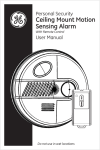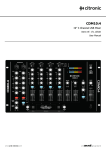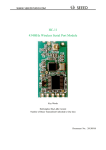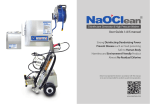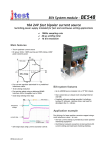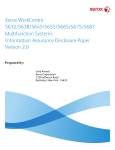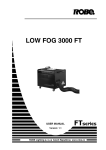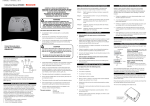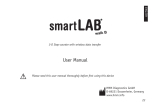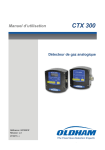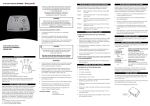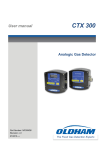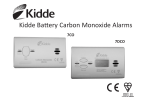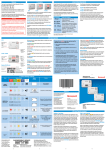Download COD100B Carbon Monoxide Alarm - Sparks Electrical Wholesalers
Transcript
COD100B Carbon Monoxide Alarm Item ref: 350.135UK User Manual Thank you for choosing this Mercury carbon monoxide alarm. This alarm is design to protect you and your family from carbon monoxide poisoning. Any household or indoor area that has a fireplace or combustion appliance will have an increasing chance of rising carbon monoxide levels, especially in older buildings where ventilation is lacking. Please read through the following manual carefully on how to correctly install, operate and maintain the device, and also for action to be taken in the event of detection of dangerous CO levels. Product Specifications: Apparatus Batteries Type B 3 x AA (supplied) Alarm level Sensor 85dB @ 1m Electromechanical Static working current Operating temperature 80uA 0°C to 45°C Storage temperature Humidity -20ºC to 50ºC 0 to 90% RH Lifetime Dimensions 7 years from first use 120 x 87 x 40mm Weight 220g (incl. batteries) Product layout: 350.135UK User Manual 1. 2. 3. 4. Power LED indicator Fault LED indicator Alarm LED indicator LCD display 5. 6. 7. 8. Alarm output Test/Menu button Back cover catch Battery compartment Installation: Start up: Remove the alarm from the packaging and slide the back cover downwards to reveal the battery compartment. Insert 3 x AA batteries (supplied) to the correct polarity, the alarm will beep once and all 3 LEDs will flash to indicate power up. When the LCD display on the front starts to display information, the alarm is successfully powered and has start working. Location: For houses and buildings with multiple rooms, it is recommended to install one alarm per room. If not possible then at least one alarm per level. It is advised to locate the alarm near the potential source of CO, such as rooms with a boiler, fireplace or gas oven. For optimum detection, the alarm needs to be installed at least 1.5m above the ground, 0.3m below the ceiling and 1.5m from the corner of the room. DO NOT locate alarm: Next to a window or a door. On the floor where unit may get kicked or damaged. Behind fans, air-con units or any sort of ventilation. Contained spaces such as inside a cupboard. Behind furniture or curtains, alarms must not be obstructed. Cold or hot environments. (no less than 0ºC or no more than 45°C) Dusty areas, this may block the sensor. Too close to an open flame, this can leave carbon deposits on the sensor, reduce its sensitivity and give false readings. Directly above a heater or cooking appliance. Where a lot of moisture is present, e.g. bathroom or above a sink. Outdoors, this alarm is designed for indoor use only. 350.135UK User Manual Installation: After finding an appropriate location, the wall bracket can be screwed onto the wall using the supplied hardware. Alternatively it can be stuck on using a pad sticker or just rested on top of a unit. To mount the bracket using hardware, use the mounting plate as a guide to mark the two holes. Drill these holes 6mmØ , 30mm deep. Insert the plugs into the hole and screw the bracket on, ensuring the raised side is facing outward and is pointing upward correctly as shown. Push the back of the alarm against the bracket and slide down until it clicks to lock in place. The battery compartment has latches that rise up to prevent the alarm being installed without batteries, therefore please ensure the batteries are inserted before installing the alarm. Operation: The LCD screen and LEDs on the front of the alarm give vital information of the working condition of the alarm and important ambient readings of the surroundings. When the alarm is powered, the green power LED will flash once every 45 seconds to indicate it is working. When the working voltage drops below 3.5V, the alarm will beep when the power LED flashes. This indicates the battery power is insufficient; please replace battery as soon as possible. On the LCD display, the battery status is also shown constantly: Indicates batteries are at full capacity and alarm is working with sufficient power. Indicates batteries have sufficient capacity and alarm is working with sufficient power. Indicates batteries capacity is getting low but alarm still has sufficient power. Indicates batteries are critically low and alarm is working on the minimum required power and requires replacement as soon as possible in order to keep the alarm functional. It is recommend to manually perform testing once a week. To perform a manual test, simply press the test button for 1 second and the alarm will enter test mode. All three LEDs will flash once and alarm will sound 2 cycles of 4. The LCD screen will read “---“ to indicate it’s testing. All LEDs and the LCD display should resume back to normal after a few seconds. 350.135UK User Manual The alarm will perform self-checking of the sensor every 2 minutes. Under normal conditions no LEDs will flash. If the sensor fails, the amber fault LED will flash once every 2 minutes together with two long beeps. Also the LCD will display the error message as below, this indicates the alarm sensor or circuitry has failed. Please stop using the alarm immediately. The error can be caused by either loose connections on the circuitry, short circuit or sensor contaminated by other strong chemical fumes. Please leave the alarm in clean open air for 24hr and see if error disappears. If the error remains, please replace alarm immediately to remain protected from carbon monoxide. The red alarm LED will only flash when the carbon monoxide count reaches an alert level and activates the alarm. Under normal conditions the carbon monoxide count should be below 25ppm. Therefore when the count is below 25, the LCD will only display 0ppm and the temperature reading in a 30 second cycle. To meet EN50291 standards, the alarm will activate within following time limits when different critical CO level is met. CO count (parts per million) Alarm response time 33ppm 120 mins + 55ppm Within 60 to 90 mins 110ppm Within 10 to 40 mins 330ppm Within 3 mins When the alarm is activated the frequency of the sound will increase with the concentration, when the concentration of the carbon monoxide reaches above 550ppm the alarm will sound continuously with the LCD displaying “Hco” (high carbon monoxide) as below. This indicates a dangerously high concentration of carbon monoxide present and all persons must evacuate the building IMMEDIATELY. When alarm is activated it can be temporarily silenced by pressing the TEST button, the alarm LED will remain flashing to indicate the presence of high concentration of carbon monoxide. ONLY silence the alarm when you are 100% sure that the source of the carbon monoxide has been dealt with. 350.135UK User Manual The alarm is designed to record maximum readings and average readings over the last 24hour period. This allows you to keep track of the presence of carbon monoxide without needing to be present in the room. To bring up the reading, simply press and hold TEST button until “Ph=” is displayed on the front screen. It will move to the next page to show the peak reading for the past 24 hours automatically after a short wait, or you can manually press the TEST button to enter the next page if you do not wish to wait. The following page will display “24H” to indicate it will display the average reading next. Press the button again or wait and the average reading will show. The “PPM” will flash on the average reading display to differentiate it from the peak reading. The following menu option allows you to clear the record. When “clr” appears on the screen, simply press and hold the TEST button until “P--” is displayed which indicates the record has been deleted. Maintenance: In order to maintain the sensitivity of the alarm, dust needs to be removed from the surface on a regular basis. To dust use a slightly damp cloth, a brush or brush attachment of a vacuum cleaner. Do not use any solvent based cleaner as the sensor is sensitive to all active gas including chemical cleaners. Always perform a manual test after cleaning to ensure the alarm is working normally. Also, the battery compartment needs to be checked on regular basis for signs of battery acid leakage. Remove batteries immediately if any signs of leakage occur. Clean the compartment with a clean tissue/cloth before replacing with new batteries. Avoid below action to prevent the alarm from damage: Do not allow the alarm to come into contact with any coloured or heavy smelling gas as this will contaminate the sensor and false readings will occur. Do not spray aerosols near the alarm, such as: air freshener, insect killer, perfume, hair spray etc. as this will result in false readings or contamination of the sensor. Do not paint over the alarm, always remove alarm from the bracket before painting and wait for paint to be fully dry before reinstalling the alarm. Avoid shock or impact on the alarm, if accidentally dropped check if the battery connection is still intact and perform a manual test to ensure the alarm is working correctly. Do not attempt to repair or modify the alarm. Any modification may cause alarm to malfunction and fail to operate in a life-threatening situation, therefore modification and repair is strictly restricted. In the event of contamination, leave alarm in fresh air for a minimum of 30 mins to up to a week to see if it recovers. If readings are still false replace the alarm immediately. 350.135UK User Manual What is carbon monoxide? Carbon monoxide (CO) is a highly poisonous gas that has no taste, colour or smell. Carbon monoxide is a cumulative poison meaning long-term exposure to low levels may cause symptoms. This alarm is time-weighted – the higher the level of CO, the sooner it will alarm. What produces CO in the home? Many appliances can produce deadly CO levels if they are not in fully working order. Items such as wood burning stoves, gas boilers, gas fires, gas hobs and ovens, oil and coal burning units, portable gas heaters, blocked flues and chimneys, car fumes from an integral garage and even barbeques. This alarm is not a substitute for proper maintenance of your appliances. What should I do if the CO alarm sounds? 1. IMMEDIATELY open all doors & windows for ventilation & turn off all combustion appliances. 2. Evacuate everyone outdoors or to an open door or window for fresh air. Do a head count to check all persons are accounted for. 3. DO NOT re-enter the premises or move away from the door/window until the alarm has stopped. 4. Call the UK Emergency Gas Services: 0800 111 999 5. Seek medical help immediately for those suffering with CO poisoning. 6. DO NOT use appliances again until they have been checked by a qualified technician and the fault clearly identified and rectified. How to identify symptoms of carbon monoxide poisoning: Carbon monoxide poisoning accounts for up to 50 deaths on average per year in the UK, long period exposure will lead to brain damage and can be lethal if ignored or unnoticed. Therefore it is very important to identify the symptoms at an early stage. Symptoms Mild Headache, nausea, fatigue (often misdiagnosed as flu or food poisoning) Moderate As above but more obvious, also tiredness, dizziness, lack of concentration, shortness of breath or chest pains Severe Severe headaches, convulsions, seizures, loss of consciousness, vital organ failure. Possible death within 2 - 3 hours 350.135UK User Manual Carbon monoxide poisoning action and treatment: In the event of carbon monoxide poisoning, switch off/put out the source of carbon monoxide immediately if known. Open all doors and windows to allow fresh air to flow in and evacuate all persons from room or building. Seek medical support immediately. Contact the emergency gas service and allow them to inspect the building to ensure it is safe before re-entering. Mild carbon monoxide poisoning will clear on its own after the person is removed from the source of carbon monoxide. For moderate level poisoning seek medical advice as they will need to be treated with pure oxygen. Severe cases of poisoning will require immediate medical assistance call 999. In severe cases hyperbaric oxygen chamber treatment may be required. Prevention of carbon monoxide poisoning: Do not use domestic fueled appliances in enclosed spaces. Do not use fueled generators in enclosed space. Paraffin/flueless heaters should not be used in a bedroom or an enclosed space. Ensure all flues, chimneys or other ventilation is clear from obstruction. Ventilate your home on a regular basis. Do not service, repair, install or modify appliances yourself. Always ensure any work is carried out by licensed, reputable, and qualified engineer only. Learn how to recognise CO poisoning symptoms. If mild symptoms reduce or go away when you are away from the room or building, then it is highly likely you are open to chronic carbon monoxide exposure. Seek help from licensed engineer to perform checks on all fuel running appliances within the household. This alarm comform to BS EN50291-1:2010 This product is classed as Electrical or Electronic equipment and should not be disposed with other household or commercial waste at the end of its useful life. The goods must be disposed of according to your local council guidelines. Errors and omissions excepted. Copyright© 2014. AVSL Group Ltd. 350.135UK User Manual








